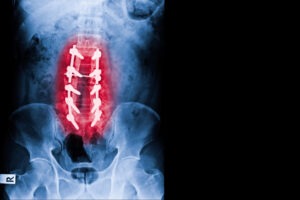Common spine conditions and disorders treated by spine specialists

Spine specialists are trained to diagnose and treat a variety of conditions and disorders related to the spine.
Here are some common spine conditions and disorders that spine specialists may treat:
Herniated disc: A herniated disc occurs when the soft cushion between the vertebrae in the spine protrudes out of place, which can cause pain, weakness, and numbness.
Spinal stenosis: Spinal stenosis is a condition where the spinal canal narrows, causing pressure on the spinal cord and nerves, which can cause pain, tingling, and weakness in the back, legs, or arms.
Scoliosis: Scoliosis is a condition where the spine curves sideways, which can cause uneven shoulders, hips, and a hump on one side of the back.
Degenerative disc disease: Degenerative disc disease is a condition where the discs between the vertebrae in the spine begin to break down, which can cause pain and stiffness in the back.
Osteoporosis: Osteoporosis is a condition where the bones in the spine become weak and brittle, which can cause compression fractures and chronic pain.
Spinal cord injury: Spinal cord injuries occur when the spinal cord is damaged, which can cause paralysis and loss of sensation below the injury site.
Sciatica: Sciatica is a condition where the sciatic nerve, which runs from the lower back down to the legs, becomes compressed or irritated, causing pain, tingling, and numbness in the legs.
Spine specialists may use a variety of treatment options, including non-surgical treatments such as physical therapy, pain management, and medication, as well as surgical treatments such as spinal fusion, laminectomy, and discectomy, to manage and treat these conditions.
Non Surgical and Surgical treatment options for Spine condition and disorder
Spine specialists recommend non-surgical treatment options for spine conditions and disorders, depending on the severity and nature of the condition.
Here are some common non-surgical treatment options for spine conditions:
Physical therapy: Physical therapy can help to improve mobility, flexibility, and strength in the spine, which can alleviate pain and prevent further damage. Physical therapy may include exercises, stretches, and manual therapy.
Pain management: Pain management techniques, such as medication, acupuncture, and nerve blocks, can help to alleviate pain and discomfort associated with spine conditions.
Lifestyle modifications: Making lifestyle modifications such as maintaining a healthy weight, quitting smoking, and practicing good posture can help to alleviate pain and prevent further damage.
Chiropractic care: Chiropractic care involves the use of manual therapy techniques to realign the spine and improve mobility.
Massage therapy: Massage therapy can help to alleviate muscle tension and reduce pain associated with spine conditions.
Epidural injections: Epidural injections involve the injection of a steroid medication into the epidural space of the spine to reduce inflammation and alleviate pain.
Traction: Traction involves the use of a system that applies gentle pulling force to the spine to relieve pressure on the discs and nerves.
Surgical treatment options for spine conditions and disorders recommended by spine specialists when non-surgical treatments are ineffective or the condition is severe.
Here are some common surgical treatment options for spine conditions:
Spinal fusion: Spinal fusion is a surgical procedure that involves fusing two or more vertebrae in the spine together, which can help to stabilize the spine and reduce pain.
Laminectomy: Laminectomy is a surgical procedure that involves removing a portion of the vertebral bone called the lamina, which can alleviate pressure on the spinal cord and nerves.
Discectomy: Discectomy is a surgical procedure that involves removing all or part of a herniated or degenerated disc in the spine, which can relieve pressure on the nerves and alleviate pain.
Foraminotomy: Foraminotomy is a surgical procedure that involves removing bone or tissue that is compressing a spinal nerve root in the spinal column.
Artificial disc replacement: Artificial disc replacement is a surgical procedure that involves removing a damaged disc in the spine and replacing it with an artificial disc.
Kyphoplasty or vertebroplasty: Kyphoplasty or vertebroplasty is a minimally invasive surgical procedure that involves injecting bone cement into a compressed or collapsed vertebral body to stabilize the spine.
Spinal cord stimulation: Spinal cord stimulation is a surgical procedure that involves implanting a small device in the spine that sends electrical impulses to the spinal cord to alleviate pain.
Spine conditions and disorders can cause significant pain and discomfort, and can affect an individual’s quality of life. However, spine specialists are trained to diagnose and treat a variety of spine conditions using a range of non-surgical and surgical treatment options.
The appropriate treatment option depends on the severity and nature of the condition, and should be discussed with a best spine doctors in bangalore to determine the best course of treatment for an individual patient.
About Axon
Axon Speciality hospital was started in the year 2009 and has been serving people successfully in and around Indiranagar from last 12 years under the leadership of Dr. Praveen M and Dr.Amar P.
Quicklinks
- Difference between Kidney stones & Gall bladder stones
- Diet for a Kidney disease patient
- Important questions to ask your Gastroenterologist
- When do you need knee replacement surgery?
- What is Arthroscopic surgery?
- How to improve your Joint health?
Contact Us
![]() 080 4334 6333
080 4334 6333
+91 99726 63536
![]() axonhrblr38@gmail.com
axonhrblr38@gmail.com
![]() 321, 6th Main Rd, HAL 2nd Stage, Indiranagar, Bengaluru – 560038
321, 6th Main Rd, HAL 2nd Stage, Indiranagar, Bengaluru – 560038
© Copyright 2021, All rights reserved by Axon Speciality Hospital. Designed by Shloka Concepts

